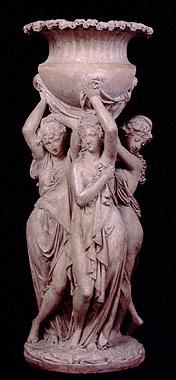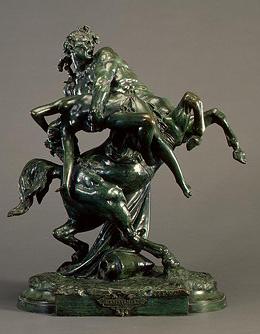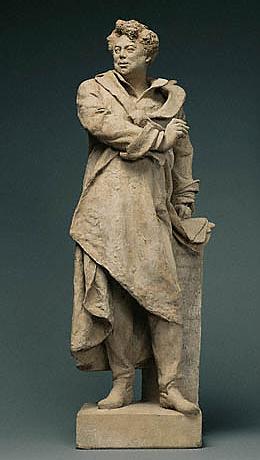Rodin in his time: Biographical materials saved from the Web |
|
|
Albert-Ernest Carrier-Belleuse (1824-1887)
Text archive copy of: http://www.nga.gov/cgi-bin/pbio?56400
|
|
|
Carrier-Belleuse is the name used by this sculptor--born Carrier de Belleuse--on his mature pieces, after initially signing works "A. Carrier." His career began firmly in the applied arts, with his apprenticeship at thirteen to a Parisian ciseleur today known as Bauchery (or Beauchery), and he did subsequent work for Jacques-Henri Fauconnier and Fannière Frères. His formal education took place at the Petite Ecole--chosen after an unhappy stint at the Ecole des Beaux-Arts in 1840 under the direction of David d'Angers, his official master. While at the Petite Ecole in the 1840s, Carrier-Belleuse began his lifelong practice of providing commercial houses with models for edition, as statuettes or as ornament for functional pieces. Around 1850, the sculptor moved to England as a designer for Minton China Works, at Stoke-upon-Trent, as well as for Wedgewood, Coalbrookdale Ironworks, and Graham & Jackson furniture makers. Even after returning to Paris in 1855, he continued to send models to British firms throughout his life. |
The Three Graces, n.d. |
|
(possibly with Auguste Rodin) |
He began to garner acclaim as a fine-arts sculptor after ten years of showing in the Salon, beginning with two portrait medallions in 1850 and a flurry of busts and groups with mythological or historical subjects between 1857 and 1861, the latter of which earned him a third-class medal. Carrier-Belleuse finally received serious attention in 1863, when the emperor bought his marble Bacchante from the Salon for the Jardins des Tuileries (Musée d'Orsay, Paris). Four years later, his marble Messiah was purchased by the State from the Salon of 1867 and allotted to Saint-Vincent-de-Paul in Paris; it earned him a Medal of Honor and the cross of the Légion d'Honneur.From that time onward, Carrier-Belleuse was established internationally as a high-art sculptor as well. He produced abundantly for a variety of international patrons in most categories of three-dimensional work--public monuments, for example, Masséna (1867, Nice), allegorical reliefs for Parisian buildings (Palais des Tuileries and Banque de France, 1865-1866), tombs for foreign heroes (San Martín Cathedral, Buenos Aires, Argentina), and classicizing figure subjects such as Sleeping Hebe for the Salon (1869, marble; Musée d'Orsay, Paris)--while simultaneously maintaining high visibility in the applied arts. |
|
Carrier-Belleuse raised a critical hue and cry during his lifetime with his sensuous female nudes, especially Angélique, shown in 1866 (marble, lost; reduced terracotta variant, private collection). Broadly in the vein of nineteenth-century "voluptuous antiquity," the work pursues more realism and seductive materiality than Pradier's classical women through their violently sinuous movement and polychromy. |
|
|
Like Auguste Clésinger (1814-1883), who had riveted Paris in 1847 with his Woman Bitten by a Snake (Musée d'Orsay, Paris), Carrier-Belleuse violated the idealist canon of pure marble by adding real jewelry of his famous contemporaries such as Froment-Meurice. However, the sculptor applied his enormous capacity for modeling and design to a variety of stylistic and expressive modes. The neo-baroque realism of his heroic monuments differs signally from the neo-rococo preciousness, material richness, and vivacity for which he is best known. Yet he explored few expressive extremes outside the dionysiac. Open violence and pathos are rare in his work; his most typical expressive mood was the intimate and wittily spirited. He consequently gave varied and winsome life to historical figurines and fantasy busts, and was a masterful portraitist. His prolific portraiture of both men and women is often compared to Houdon's, as it similarly conveys extraordinary likeness and psychological life within richly tactile, modeled work. For all his association with rococo sensuality, Carrier-Belleuse's mastery at articulating form gave as much vitality and appeal to the marbles carved from his models as to his many works in clay and bronze. |
Model for a Monument to |
|
The sculptor sold finished serial work directly through his studio and at auction, and thus counted among the most actively entrepreneurial of his fellow professionals, like Jean-Baptiste Carpeaux and his senior, the animalier Christophe Fratin. His models and published designs integrated the human figure within functional forms--torchères and table service, for instance--in a variety of styles, and with imagination and verve; they were commercially successful and influential for decades. Carrier-Belleuse was appointed director of works at the state Manufacture de Sèvres in December 1875, where he greatly improved the quality of the models and expanded production in biscuit. A charter member of the new professional organization for the applied arts (the Union Centrale des Beaux-Arts Appliqués à l'Industrie), founded in the early 1860s, he was enormously important in elevating the stature of the applied arts and for the sheer quality of his ornamental design. For that contribution to France alone the artist was promoted to officer of the Légion d'Honneur in 1885. Thanks to his huge studio production and responsibilities at Sèvres, he had considerable impact on the art and careers of younger sculptors who worked for him, notably Auguste Rodin, whether in Paris or in Brussels, where both moved during the Franco-Prussian War of 1870-1871. Bibliographical References:
|
|
|
|
|
|
Notice:
Museum logos appear only as buttons linking to Museum Websites and do not
imply any |
|


